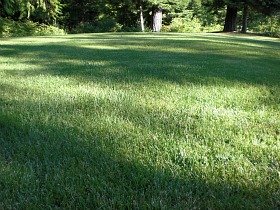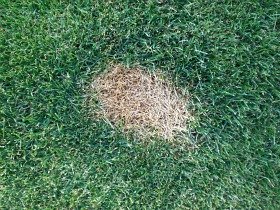Lawn problems can’t be avoided – if you’re growing grass, sooner or later, a pest is going to show up looking for a free meal or a comfortable place to live.
Pests include weeds, insects, disease-causing organisms, or any animal that causes damage to grass plants and is a source of common lawn problems.
A healthy lawn will limit pest damage and quickly recover. When a pest becomes a problem, it’s a sign that your grass is not healthy. Usually, the best fix is creating conditions that are good for your grass and bad for pests.
Top 10 Causes of Most Lawn Problems:
- Improper Watering
- Too Much or Too Little Fertilizer
- Mowing Too Low
- Weeds
- Chemical Misapplication
- Soil Compaction
- Shad
- Selecting the Wrong Grass Type
- Poor Drainage
- Pests: Insects, Disease Pathogens, Wild Animals
How do you create the environment that your lawn will love?
While the weather can’t be manipulated – you can manage grass type, site conditions and maintenance practices. When these are right – you’ll have a happy, green lawn.

Grass Types
If you don’t know what you are growing, then you won’t know how to grow it! Different grasses have different watering, mowing and fertilizer requirements, what kind of grass are you growing?
A very important Rule of a Green Thumb is selecting the right plant for your site. Trees, shrubs, flowers, vegetables…or grass – whatever you plant in your yard has to be able to live in the spot it’s planted.
There are literally hundreds of improved grass cultivars – cultivated varieties – developed to be grown in various climates and uses. Be sure to purchase certified seeds and choose a blend of these improved grass varieties to plant in your new lawn or when overseeding your existing lawn.
Site Conditions
Many lawn problems are caused by poor soils. Compacted and infertile soils can be improved with core aeration and compost topdressing. Recycling grass clippings – grasscycling – returns nutrients and organic matter to the soil.
Drainage
Lawn grasses will not tolerate standing water, poor surface drainage can sometimes be fixed by simply topdressing low spots with soil. Large puddles may require installing a drainage system – a French drain will do the trick.
Another option is installing a rain garden in the low spot. A rain garden is simply a depression that is designed to catch surface water and planted with plants that don’t mind having wet feet.
Prevent Soil Compaction
Grass will not grow in areas that get a lot of traffic. High traffic can be diverted off lawns or paths installed in the worn areas.
Heavy Shade
Grass does not grow well in heavy shade. Tree canopies can be thinned to let light filter down to the grass or you could plant fine fescues and other shade-tolerant species in shady spots. Instead of fighting shade, consider giving trees their own space by mulching under them or planting a shade-tolerant ground cover.
Lawn Maintenance Practices
Mowing, watering and fertilizing – do these right and your grass will be happy. These are the most important maintenance practices and they are intertwined. Mow too short and you will need to water and fertilize more. If water is too much, you’ll need to mow and fertilize more frequently. A lawn that lacks nutrients will be weak and thin – weeds will eventually move in.
Check out The Basics of Lawn Care for all the details on proper mowing, watering and fertilizing. You’ll get the dirt on how each practice affects your lawn’s health.

Want to know what your lawn needs and when to apply it?
Let the turfgrass experts on Sunday take care of the technical stuff.
Have you heard about the Sunday Smart Lawn Plan? It’s simple, do-it-yourself natural lawn care that’s customized to your soil, climate, and lawn. Delivered to you right when you need it. You apply the nutrient packets with the included hose-end sprayer…simple, professional results!
Sunday’s plant and soil nutrient products are made from food waste, seaweed, and molasses. The natural additives stimulate plant growth and activate soil life.
This is Super Environmentally Friendly lawn care!
Common Lawn Problems
What’s good for the grass is bad for the pests. What’s bad for the grass is good for the pests.
A vigorous growing lawn will take care of itself…it won’t need to be sprayed with chemicals to kill or deter pests that are causing your lawn problems.
Weeds
Weeds are a major lawn problem because they wreck the uniform appearance of your lawn.
The best weed prevention is a healthy, dense lawn.
Weeds usually spread and reproduce by seed. Seeds need contact with soil and light to sprout and grow. Broadleaf weeds and annual grassy weeds will be kept in check by a vigorously growing grass that out-competes weeds.

Insects and Diseases
Lawn Insects:
Something is out of balance when damage from insects or diseases shows up. Diseases and insects that feed on and damage grass plants generally prey on weak or stressed lawns.
Some insects are – however – attracted to a juicy, lush lawn. But a healthy lawn can handle pest damage and will quickly repair itself…probably before you notice it.
Always take an Integrated Pest Management approach to managing lawn insects and diseases – using pesticides as a last resort.
When a disease causes extensive damage to a lawn it is most likely a sign that something is out of balance and maintenance practices need to be reviewed.
It is rarely beneficial or cost-effective to use fungicides on home lawns. Using chemicals to prevent insects and diseases is a ‘band-aid’ approach to managing lawn problems – hiding the cause instead of fixing it.
Remember, if you choose to use insecticides or fungicides you risk decreasing the number of beneficial organisms living in your yard.
Mushrooms

Mushrooms are a sign that your soil is healthy and active. They are the fruiting bodies of beneficial soil fungi that show up after rains or heavy irrigation. This fungus is decomposing organic matter in the soil – it could be a deep thatch layer, a buried 2×4, a rotting tree stump or roots. Mushrooms will go away when their food supply is gone.
Moss
Lawn Moss grows in shady spots and where the grass is weak and thin. Improve the grass growth and the moss will disappear. Power raking, aerating/overseeding and a good fertilizer program will improve thin spots. If your moss problem is bad – a power rake can be used to remove the moss, giving the grass a chance to fill in before the moss returns. Plant shade-tolerant grass types – such as fine fescue blends – in shady areas and reduce heavy shade under trees by having them properly pruned.
There are some iron-based fertilizer/moss control products that can be used to “set back” and sometimes kill the moss. Dawn Ultra Dish Soap also has the same effect – it will damage the moss giving the grass a chance to fill in. Mix a couple of ounces of Dawn in a spray bottle and soak the moss.
Moss controls can be effective but if the growing conditions don’t change – favoring the grass – the moss will just return.
Damage Caused By Animals

Dog Urine
Dogs can be troublesome when they are allowed to urinate on lawns because they usually return to the same spots. Female dogs can cause more lawn damage because they tend to return to the same spots while male dogs have a habit of spraying to mark their territory.
Urine damage usually shows up as brown patches surrounded by dark green grass. The damage is caused by a build-up of nitrates from ammonia and urea in the dog’s urine.
Keeping them from doing their business in your grass is the best way to solve this common lawn problem.
There are a lot of old wives’ tales with remedies such as adding lime – lime can only be used to adjust pH – not a problem caused by dog urine. Watering the urine spots right after they go can help dilute the urea and ammonia – but you have to really soak the the spots to leach the nitrates.
How to prevent dog urine from killing grass
Other Animals…Moles, Rodents, Skunks and Birds

They dig up gardens and yards looking for food.
Damage by moles, rodents, birds and skunks usually has to be tolerated and then repaired by promoting a quick recovery through proper maintenance practices. Moles and rodents can be trapped or killed with poison baits if the problem is serious.
There are several repellents, baits and home remedies touted as effective mole control but the results are usually weak and inconsistent. Trapping is the most effective way to control moles and gophers.
